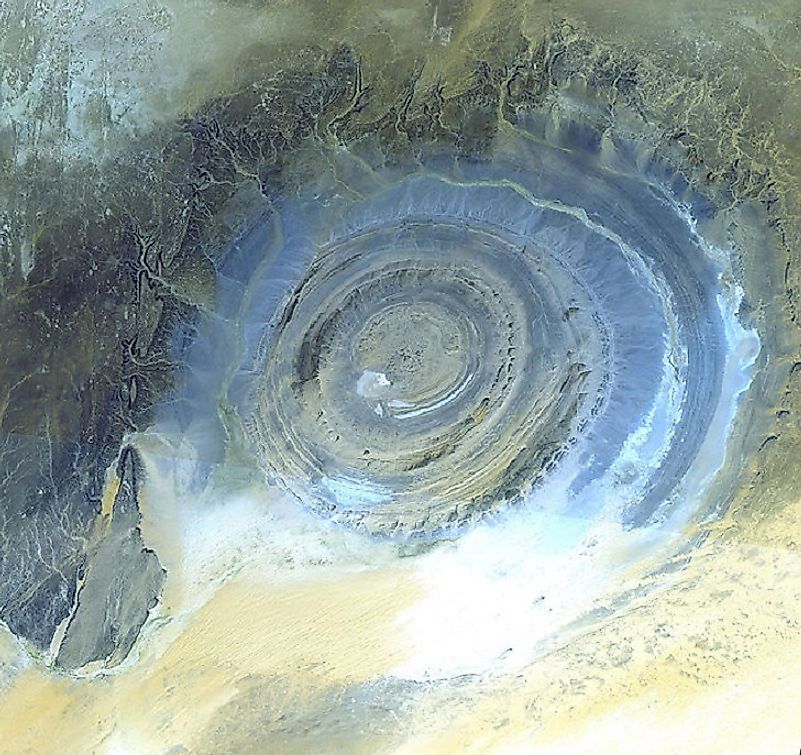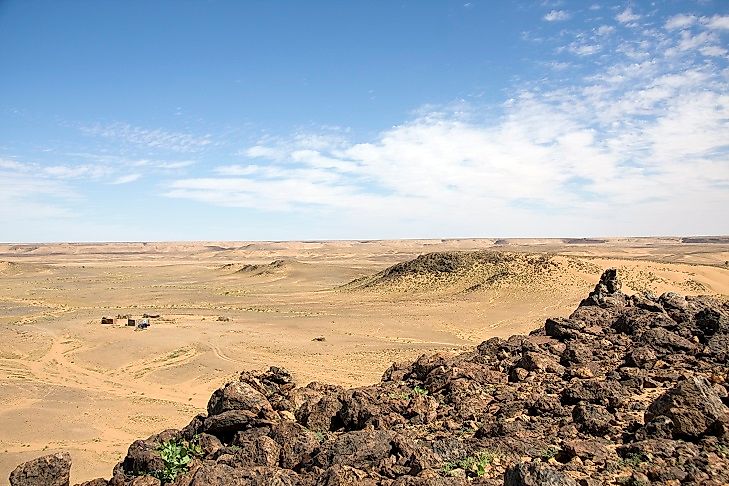The Eye Of The Sahara - Mauritania's Richat Structure

5. Description
Our Earth is full of wonders, and the Richat Structure is one of the most intriguing among them all. As per reports and images presented by NASA, the Richat structure appears like a prominent “blue eye” on the Sahara Desert when viewed from outer space. Hence, it is also known as the “Eye of the Sahara”. The structure is basically a highly eroded land form encompassing an area 40 kilometers in diameter. The sedimentary rocks of this structure is oldest at its center, belonging to the Late Proterozoic eon (2500 to 541 million years ago) while the rocks at the edges belong to the Ordovician Period (485.4 to 443.8 million years ago). On land, the Richat Structure can be accessed from the small desert town of Ouadane in the west-central part of Mauritania in western North Africa.
4. Media Coverage and Tourism
The Richat structure was first identified from outer space, appearing like a distinct feature among the vast sandy expanse of the otherwise featureless Sahara Desert. Since its discovery, the structure has served as a landmark used by astronauts. Several research institutions have also sent their team of experts to study this structure and various scientific publications describe its unique geology and geography. A video documentary by Radio Canada, the Découverte-L'énigme de Richat (a French title) is based on the Richat Structure. NASA also mentions and describes this structure on their website. Though not very well advertised, a significant volume of tourists visit this structure every year which though in the middle of a desert habitat, is accessible by car from the small town of Oudane.
3. Geological Uniqueness

The Richat structure presents a rich deposit of igneous rocks like rhyolite, kimberlite, gabbros, and carbonatite. Three nested rings representing cuestas (a hill or ridge with a gentle slope) dip outwards from the Richat structure. Towards the center of the land form, a limestone-dolomite shelf encloses a siliceous, lenticular-shaped breccia which is penetrated by various intrusions of basalt, kimberlite and volcanic rocks. The Richat Structure also hosts spectacular hydrothermal alterations as part of the structure.
2. Habitat
Very little information is available about the habitat of the Richat Structure or the type of life forms found there. However, the area surrounding the “Eye of the Sahara” is part of a vast desert with rocky and sandy features and sand dunes stretching for long distances. Very little vegetation can be observed on this landscape with vegetation primarily limited to the dry beds of the wadis and the oases. Animal populations are also extremely sparse and very little records of the same exist. The area in and around the Richat Structure experiences very little rainfall and average annual temperatures that are around 27.0° Celsius.
1. Environmental Threats
The Richat Structure is susceptible to little threat from anthropogenic activities since it is located in the midst of a sparsely populated desert habitat. Few nomadic tribes and small permanent populations in the handful of nearby villages are the only forms of human habitation in the area. The extreme arid nature of the landscape and the high temperatures do not favor human settlements in the area though some iron mines exist in the nearby areas. The rocks of the Richat Structure are thus completely at the mercy of desert winds and increased desertification due to climate change could lead to the approach of sand dunes towards this rocky bed, leading to its burial under huge volumes of desert sand in the future.











